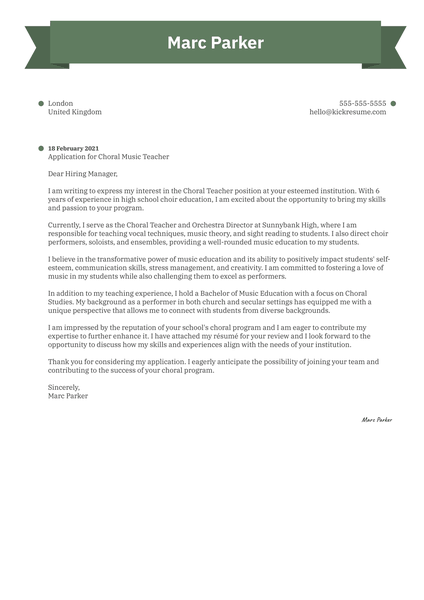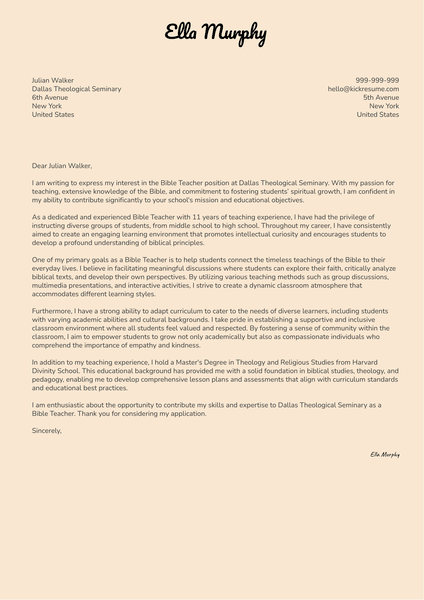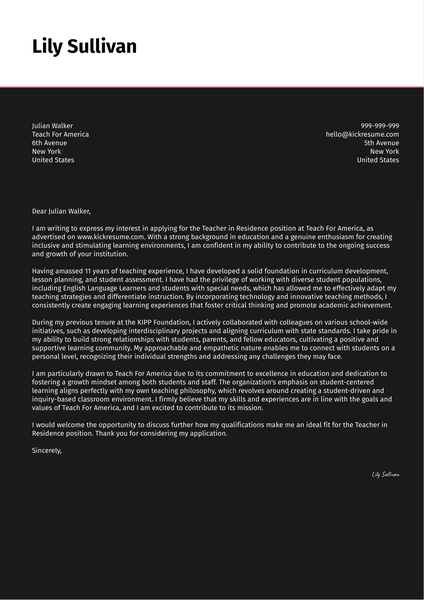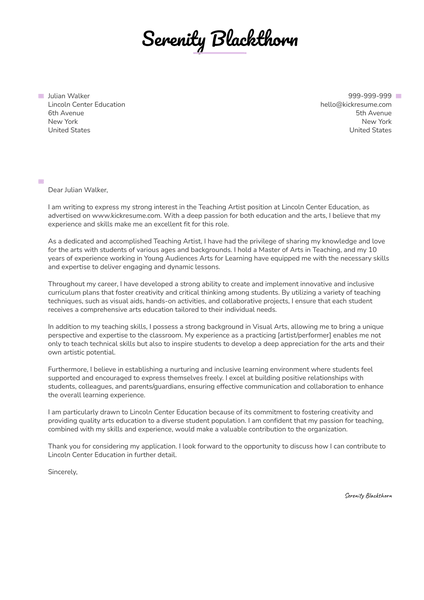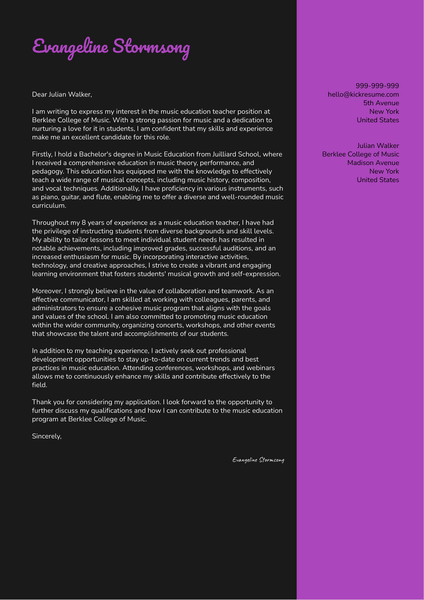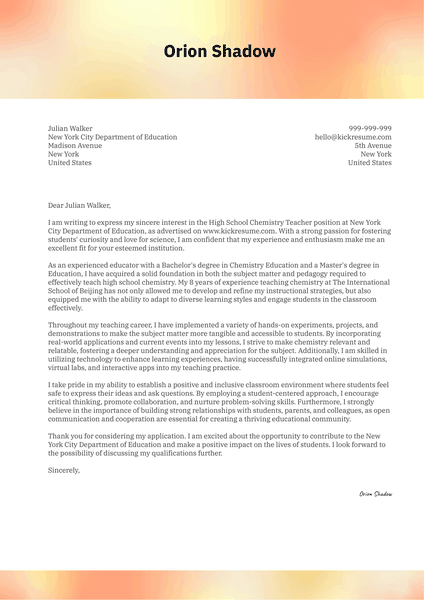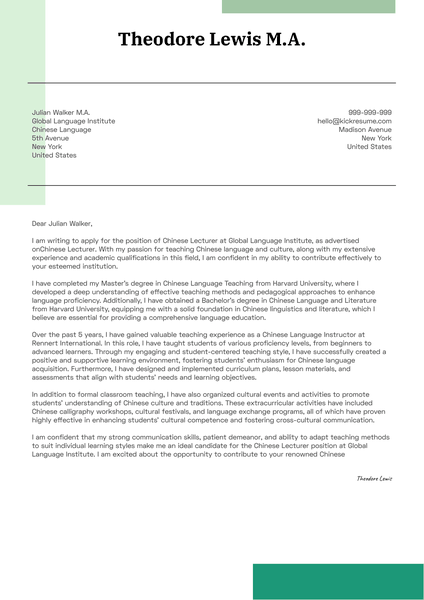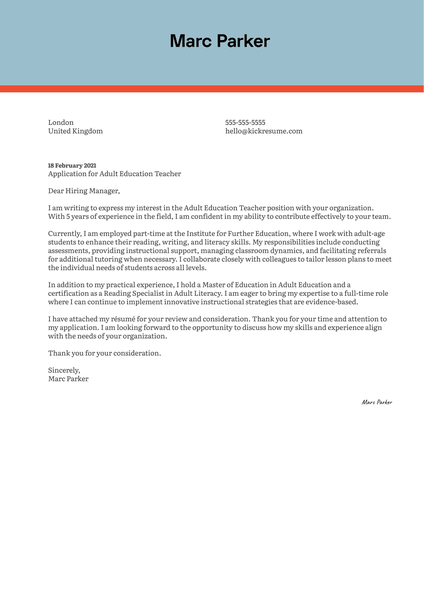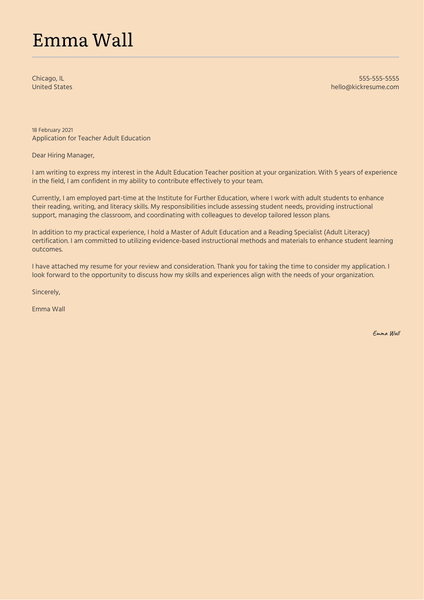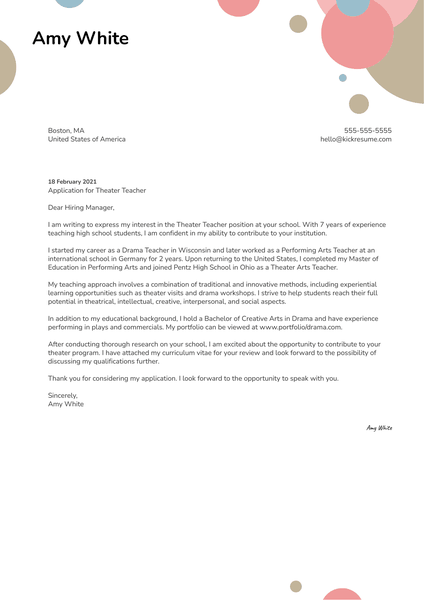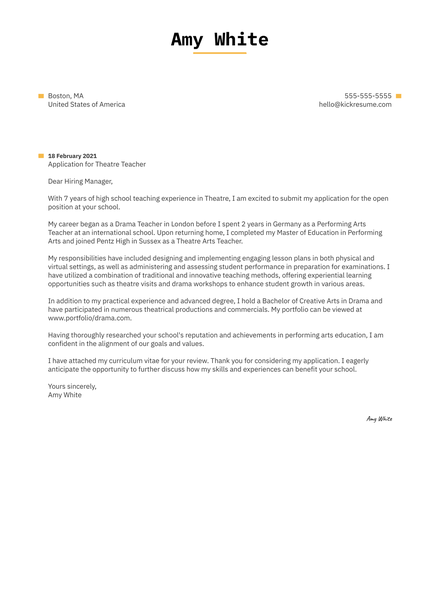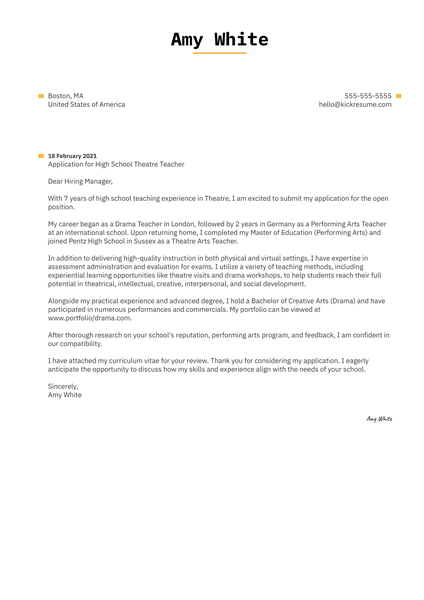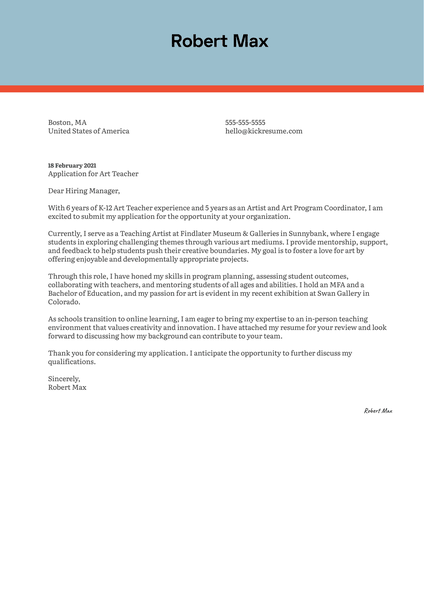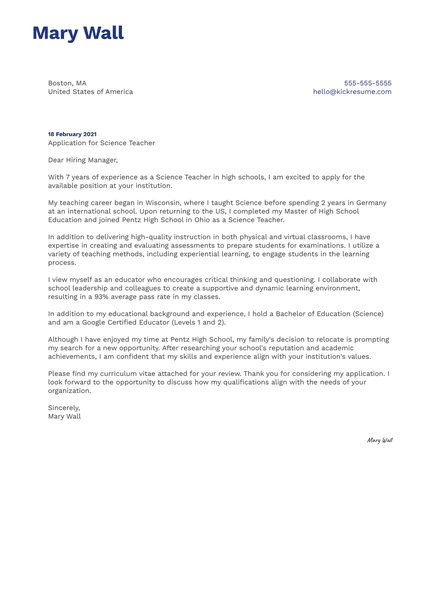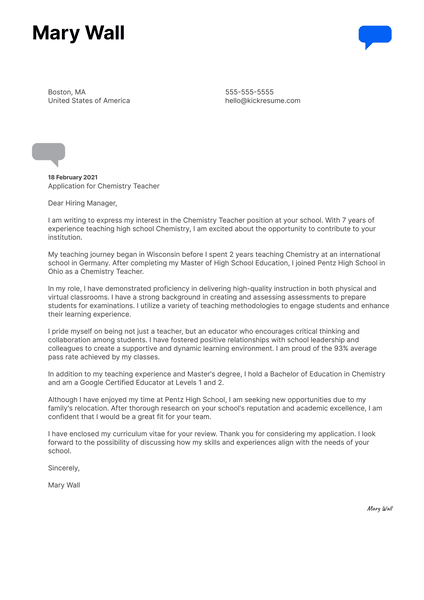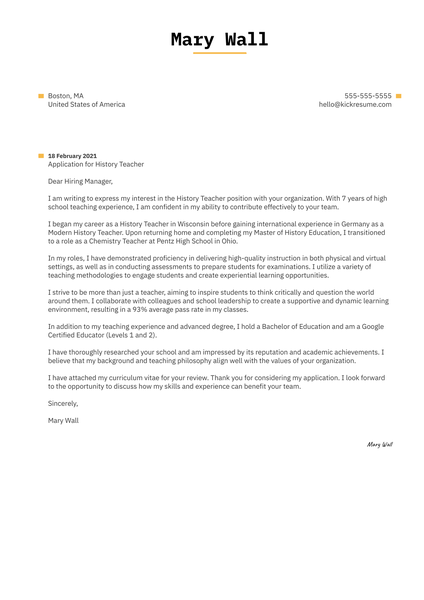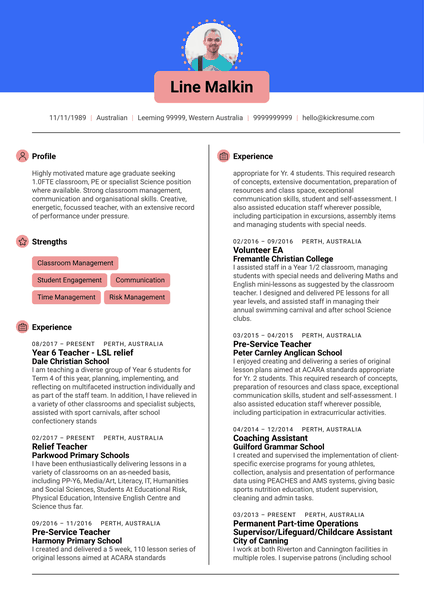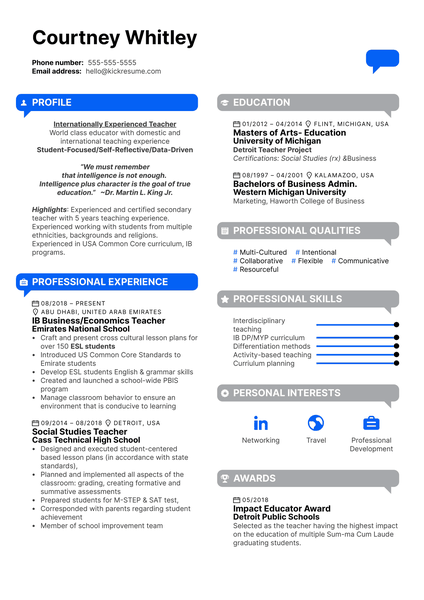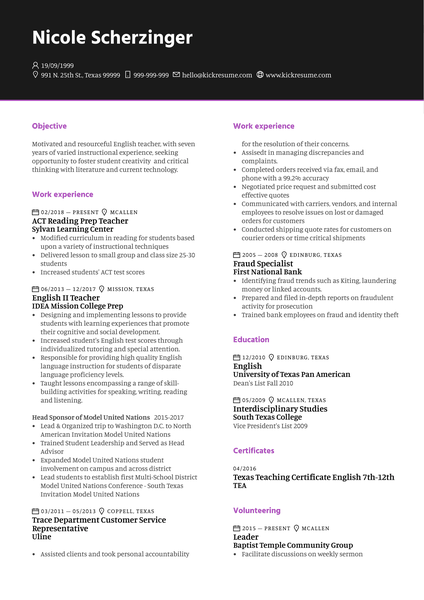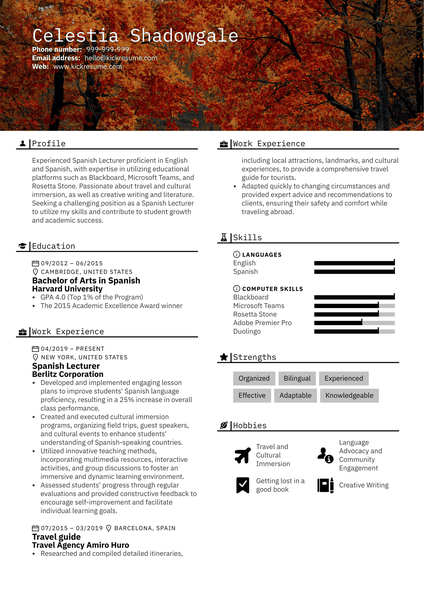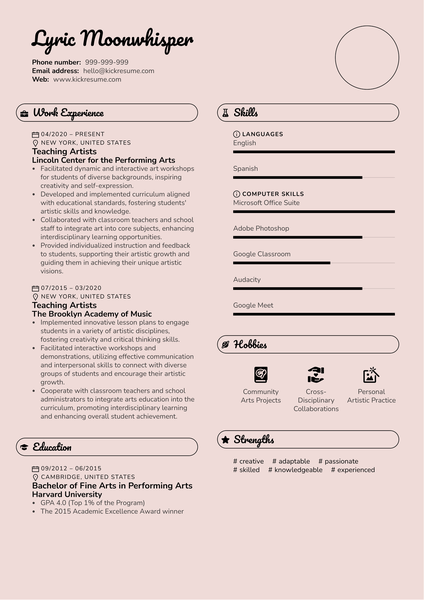Take your teacher cover letter to the next level with our easy-to-follow guide. Because even teachers need a little help sometimes. Real-life cover letter samples, specific examples, practical tips — you name it, we have it. So, let's make your cover letter shine!
In this guide, we show you the key steps for writing a cover letter as a teacher. Keep reading to learn how to:
- Properly format your teacher cover letter header & headline
- Personalize the greeting & content on teacher your cover letter
- Write an attention-grabbing teacher cover letter introduction
- Showcase your skills, accomplishments, & qualifications as a teacher
- End your teacher cover letter with a strong closing statement
- Access top resources for job-seeking teachers
Still looking for a job? These 100+ resources will tell you everything you need to get hired fast.
1. Format your teacher cover letter header & headline correctly
To begin your teacher cover letter, the first essential step is to create a well-formatted header and a compelling headline.
A cover letter header contains key information about the applicant and employer, while a cover letter headline is an optional – yet highly useful – title that introduces the main point of the letter and helps to grab the employer’s attention.
Below are in-depth explanations and examples of each of these key elements:
Formatting the header
The header of your teacher cover letter should contain all the necessary information about yourself and the school you are applying to, including:
- Your name and professional title
- Your professional contact information
- The name of the school & department you are applying to
- The address of the school
Here is an example of a well-formatted header on a teacher cover letter
Joe King, Mathematics Teacher
(123) 456-7890 | joeking@email.com | linkedin.com/in/joe-king
To: Buncombe County Middle School, Mathematics Department
1234 Street Address
Asheville, NC 28801
Writing the headline
While you do not have to include a headline on your cover letter, a well-written headline can go a long way in initially grabbing the employer’s attention and compelling them to read further.
A strong cover letter headline will include a keyword related to the position, an eye-catching number or trigger word, a powerful adjective or verb, and a promise.
Here is an example of a well-written teacher headline, followed by a brief breakdown of its core components
My Proven Track Record of Improving Student Test Scores & How I Will Teach Your Students to Succeed
Trigger Word/Number: Proven Track Record
Keyword: Student Test Scores, Teach
Adjective/Verb: Proven, Teach, Succeed
Promise: Your Students – the addition of this detail shows the employer that your cover letter is tailored to address the specific needs of their students.
2. Personalize the greeting & content on teacher your cover letter
Anytime you write a cover letter as a teacher, it is important to personalize both the greeting and content found in the document.
A personalized greeting will address a specific person within the school by name – ideally, either the school principal or the head of the department you are applying to. This shows that you have excellent attention to detail and have taken the time to research the school beforehand.
Examples of personalized greetings on a teacher cover letter include
- Dear Principal John Higgins,
- To Principal Higgins & the Mathematics Department,
- To Mrs. Jane Doe, Mathematics Department Head,
To personalize the rest of the content within your cover letter, you will need to complete further research into the school district, its demographics, and its core values. When writing your introduction and body paragraphs, use this information to explain how your skills and qualifications can meet the specific needs of the school’s students and faculty.
3. Write an attention-grabbing teacher cover letter introduction
Following the greeting of your teacher cover letter is the introductory paragraph. This introduction should be concise – between one to three sentences – and include:
- A brief overview of your professional history and goals
- A statement on why you are enthusiastic about applying to this school
- A mutual acquaintance (when possible) – naming a mutual acquaintance, such as a distinguished university professor or mentor, helps to establish an immediate professional reference and build your own professional credibility.
Here is an example of an effective introduction on a teacher’s cover letter
Dear Principal John Higgins,
I am a Mathematics Teacher with 6 years of experience teaching basic and advanced math skills to middle and high school students. I am beyond impressed by your school’s dedication to student success and would love the opportunity to contribute my skills towards this goal. My mentor, Ms. Mary Smith, is a tenured teacher at your school and recommended I apply for this position.
4. Showcase your skills, accomplishments, & qualifications as a teacher
You should always establish what subjects (Mathematics, English, etc.) you are experienced in teaching in the header and introduction of your cover letter. In the body paragraphs of your cover letter is where you will provide a more in-depth look into your skills, accomplishments, and qualifications.
An effective teacher cover letter will contain between 2 to 4 body paragraphs, using concise sentences and bullet points to help organize the information.
Key skills to describe within these body paragraphs include
- Classroom adaptability
- Lesson planning & curriculum development
- Empathy & patience
- Active listening
- Student performance assessments
- Classroom & conflict management
Here is an example of how to describe an accomplishment & qualification in a teacher cover letter
As a Mathematics Teacher with a Master’s in Math Education, I have a proven track record of raising student scores on general and end-of-year exams. At my previous position, I developed a flexible curriculum designed to meet individual student needs, resulting in a 45% increase in average exam scores.
5. End your teacher cover letter with a strong closing statement
It is crucial to finish off your teacher's cover letter strong with a thoughtful closing statement. This closing statement should include:
- An enthusiastic sentence saying you are looking forward to hearing from them
- An additional sentence stating you will follow up, including how you will contact them or how they can contact you
- A formal sign-off
Here is an example of a strong closing statement from a teacher’s cover letter
I am eager to get to know your students and how they learn best. With my years of experience and compassionate approach, I am certain I can help your students to reach their full potential. I am available to interview any weekday from 7 a.m. to 4 p.m., and will reach back out in one week if I have not heard back. The best way to reach me is at (123) 456-7890.
I look forward to discussing this opportunity with your further.
Appreciatively,
[Applicant Name]
If you have ever wondered how a cover letter differs from a resume, this article will tell you everything about the key differences between the two.
6. Top resources for job-seeking teachers
Now that you're more than well equipped to write an outstanding cover letter, it's time to dive into the job search with confidence. Here are some top resources that can help you find the perfect teaching position:
- Industry-specific job boards: Websites like HigherEdJobs,TES, or SchoolSpring offer a wealth of job listings in the education sector, from local to international teaching positions.
- General job boards: You can also browse through online platforms with border focus, such as Indeed, Glassdoor, SimplyHired, or Jooble.
- Professional associations: Associations for teachers offer access to great wealth of resources from job listings, to networking opportunities, publications, and training. You can, for example, join: the National Education Association (NEA), the Education International (EI), or the European Educational Research Association (EERA).
- LinkedIn: LinkedIn has become a valuable resource for educators. It's a place that allows them to network, share resources, and find job listings.
- Specialized publications: To succeed in this competitive field, you have to demonstrate your desire to learn and develop.Show the recruiters that you keep up with the latest industry news, trends, and methods. You can find all of these in “The Journal of Teacher Education,” “International Journal of Educational Research,” or “Education Week.”
- Continuous education: If you feel that your resume could use some extra certificates, consider enrolling in, for instance: the National Board Certification (NBC) or the Special Education Certification. You can also check out courses offered by online platforms, such as Coursera, edX, or Khan Academy.
Once you've found a job posting that speaks to you, proceed to research the institution. You can then use this knowledge to craft a personalized cover letter that will convince the recruiters that you're exactly who they've been searching for.
Teacher Cover Letter FAQ
How should I showcase my skills in a teacher cover letter?
You can briefly touch on real scenarios in which you've effectively utilized your teaching skills. Mention what problem you faced, how you chose to resolve it, and what results you achieved.
What are common mistakes to avoid in a teacher cover letter?
Proofread your cover letter to get rid of any grammar mistakes, misspellings, and typos. Also, make sure that your cover letter is not too generic or verbose. This could give the impression that you're just trying to fill in empty space and don't really know what youre talking about.
Is it advisable to talk about teaching methodologies in my cover letter?
Yes, but keep it relevant and concise. You can, for example, show how your methods would be applicable and beneficial to their institution. And, if the institution you're applying to is known for employing certain specific teaching methods, demonstrating that you know about it can earn you bonus points.
What's the trick to formatting my cover letter appropriately?
You want to use a professional, simple, and sleek layout. Organize the text of your cover letter into neat paragraphs, divided by enough white space. You really don't want to make your cover letter look cluttered and disorganized.
How should I handle employment gaps in my cover letter?
You have two options: either you don't mention it at all; or you address this fact briefly. Try to focus on the positives and write about constructive activities you undertook during this time. For example: courses you attended, volunteering, or certifications.





